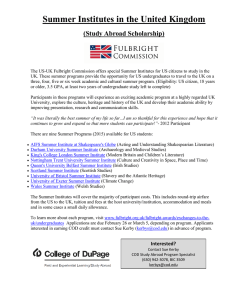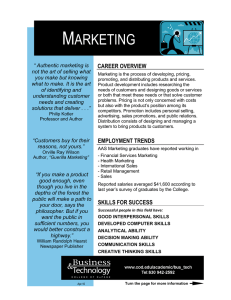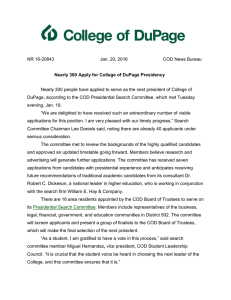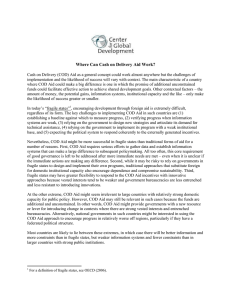To whom it may concern,
advertisement
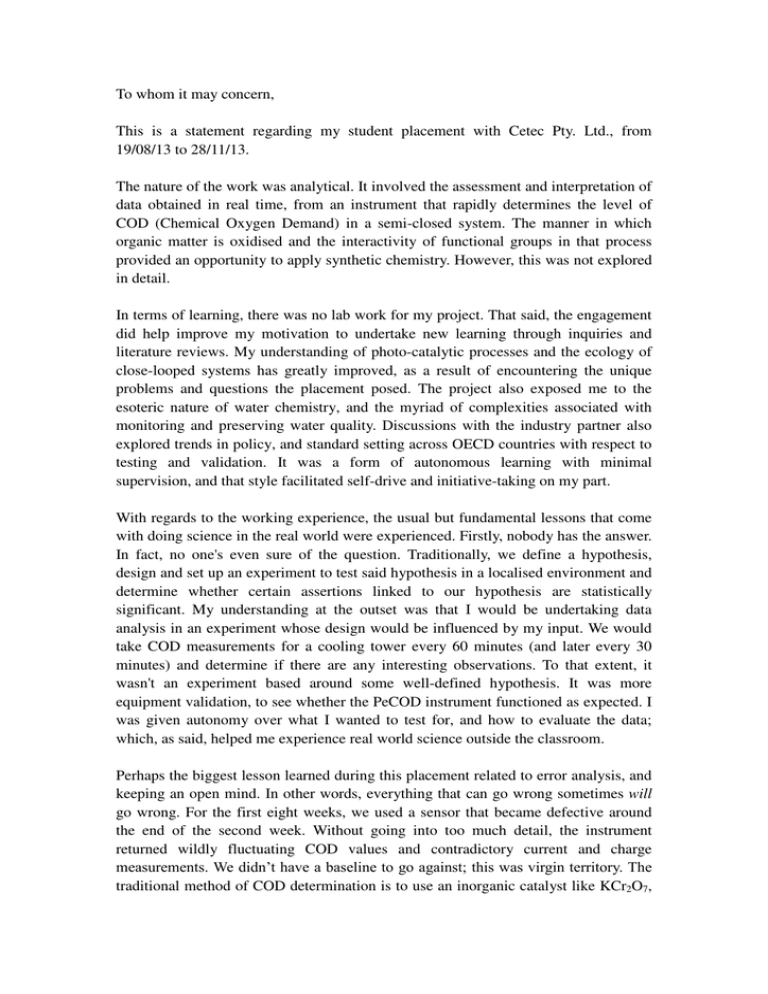
To whom it may concern, This is a statement regarding my student placement with Cetec Pty. Ltd., from 19/08/13 to 28/11/13. The nature of the work was analytical. It involved the assessment and interpretation of data obtained in real time, from an instrument that rapidly determines the level of COD (Chemical Oxygen Demand) in a semi-closed system. The manner in which organic matter is oxidised and the interactivity of functional groups in that process provided an opportunity to apply synthetic chemistry. However, this was not explored in detail. In terms of learning, there was no lab work for my project. That said, the engagement did help improve my motivation to undertake new learning through inquiries and literature reviews. My understanding of photo-catalytic processes and the ecology of close-looped systems has greatly improved, as a result of encountering the unique problems and questions the placement posed. The project also exposed me to the esoteric nature of water chemistry, and the myriad of complexities associated with monitoring and preserving water quality. Discussions with the industry partner also explored trends in policy, and standard setting across OECD countries with respect to testing and validation. It was a form of autonomous learning with minimal supervision, and that style facilitated self-drive and initiative-taking on my part. With regards to the working experience, the usual but fundamental lessons that come with doing science in the real world were experienced. Firstly, nobody has the answer. In fact, no one's even sure of the question. Traditionally, we define a hypothesis, design and set up an experiment to test said hypothesis in a localised environment and determine whether certain assertions linked to our hypothesis are statistically significant. My understanding at the outset was that I would be undertaking data analysis in an experiment whose design would be influenced by my input. We would take COD measurements for a cooling tower every 60 minutes (and later every 30 minutes) and determine if there are any interesting observations. To that extent, it wasn't an experiment based around some well-defined hypothesis. It was more equipment validation, to see whether the PeCOD instrument functioned as expected. I was given autonomy over what I wanted to test for, and how to evaluate the data; which, as said, helped me experience real world science outside the classroom. Perhaps the biggest lesson learned during this placement related to error analysis, and keeping an open mind. In other words, everything that can go wrong sometimes will go wrong. For the first eight weeks, we used a sensor that became defective around the end of the second week. Without going into too much detail, the instrument returned wildly fluctuating COD values and contradictory current and charge measurements. We didn’t have a baseline to go against; this was virgin territory. The traditional method of COD determination is to use an inorganic catalyst like KCr2O7, but the redox reaction is slow (albeit more complete) and results can take several days. My inexperience and inflexibility really showed here, unfortunately. I tried numerous methods to manipulate the data to try and deduce some sort of rational pattern out of it. Regrettably, my attempts were fruitless, because there was nothing there. The data was nonsense because the instrument was defective. For whatever reason, that thought never crossed my mind. The wisdom of hindsight suggests that the following alterations be made on future occasions, to enable efficient error detection and take timely corrective courses of action: 1) Field samples should be brought back to the lab on a regular basis to conduct a dichromate test in parallel to the PeCOD. Although there would be fewer data points in the second method, it would serve as a validation check to quickly determine the integrity of the PeCOD data. 2) Corroborate COD measurements with pH, TDS, turbidity and water temperature to help form a comprehensive picture of the dynamics within the system. This helps to isolate the ‘odd one out’. 3) Contact the original equipment manufacturer (OEM) and establish a working relationship with a consultant to help explain the error log. 4) As a scientist, be open-minded. Everything has a rational explanation, but said explanation may go against conventional knowledge. 5) Apply Occam’s Razor and the KISS principle. The simplest explanation is usually the correct one. In hindsight I needed to take ownership of the project, and make no assumptions about the help/resources that are purportedly available. But having said that, I enjoyed my time at Cetec Pty. Ltd., made valuable industry contacts, and learned a lot. Jun Gao

